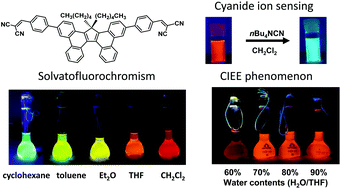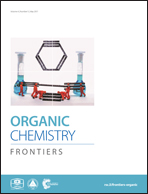A new fluorophore displaying remarkable solvatofluorochromism and solid-state light emission, and serving as a turn-on fluorescent sensor for cyanide ions†
Abstract
A new tetrabenzofluorene fluorophore, containing 2,2-dicyanoethenylphenyl groups, was synthesized and subjected to photophysical studies. This substance was found to exhibit a relatively intense fluorescence in various organic solvents associated with remarkable solvatofluorochromism [ΔλEM = 170 nm (5060 cm−1) from cyclohexane to CH2Cl2]. In addition, the tetrabenzofluorene derivative displays crystallization-induced enhanced emission (CIEE) in aqueous THF solutions. The results of theoretical calculations show that this substance has a low energy LUMO and that a high level of spatial separation exists between its HOMO and LUMO. This finding suggests that the ground-to-excited state electronic transition of this substance should have intramolecular charge-transfer character. In addition, the tetrabenzofluorene derivative serves as a turn-on fluorescent sensor for cyanide by displaying an intense blue-green fluorescence in the presence of cyanide ions.

- This article is part of the themed collection: Novel π-electron molecular scaffolds


 Please wait while we load your content...
Please wait while we load your content...